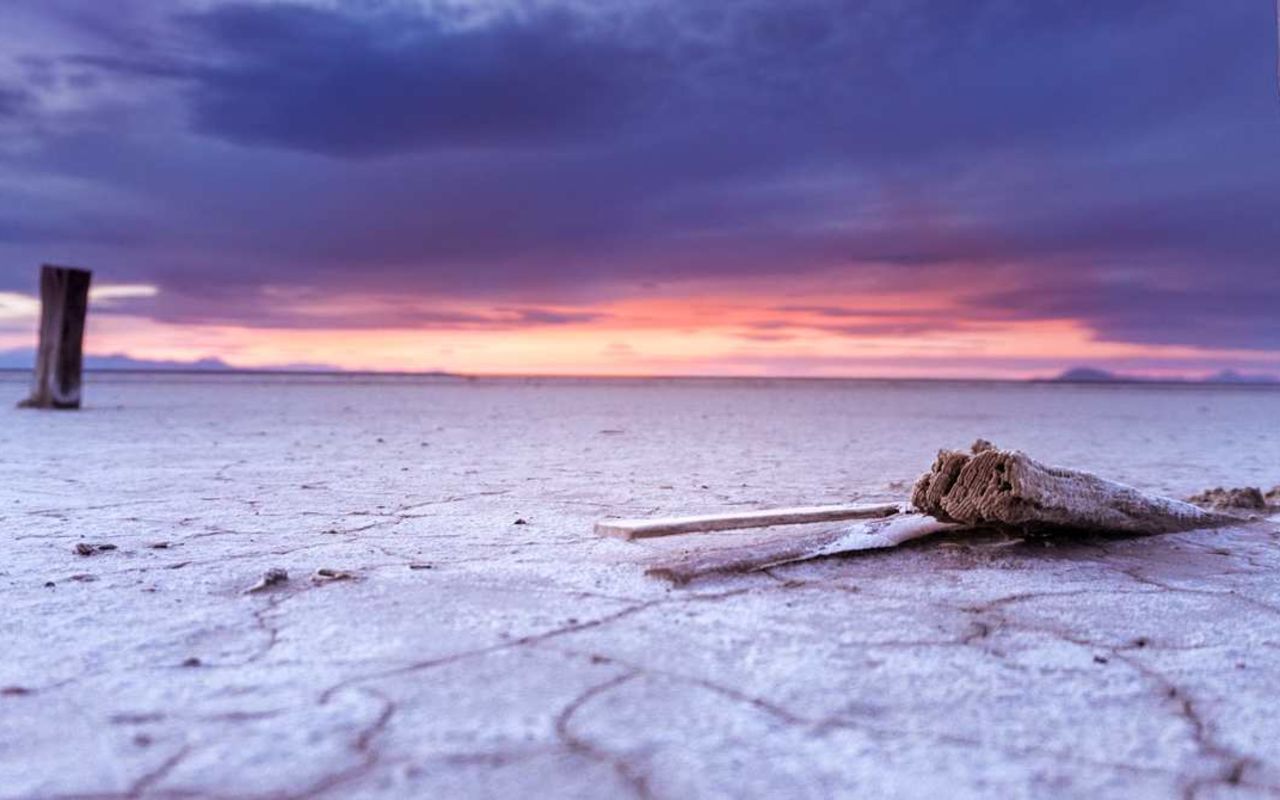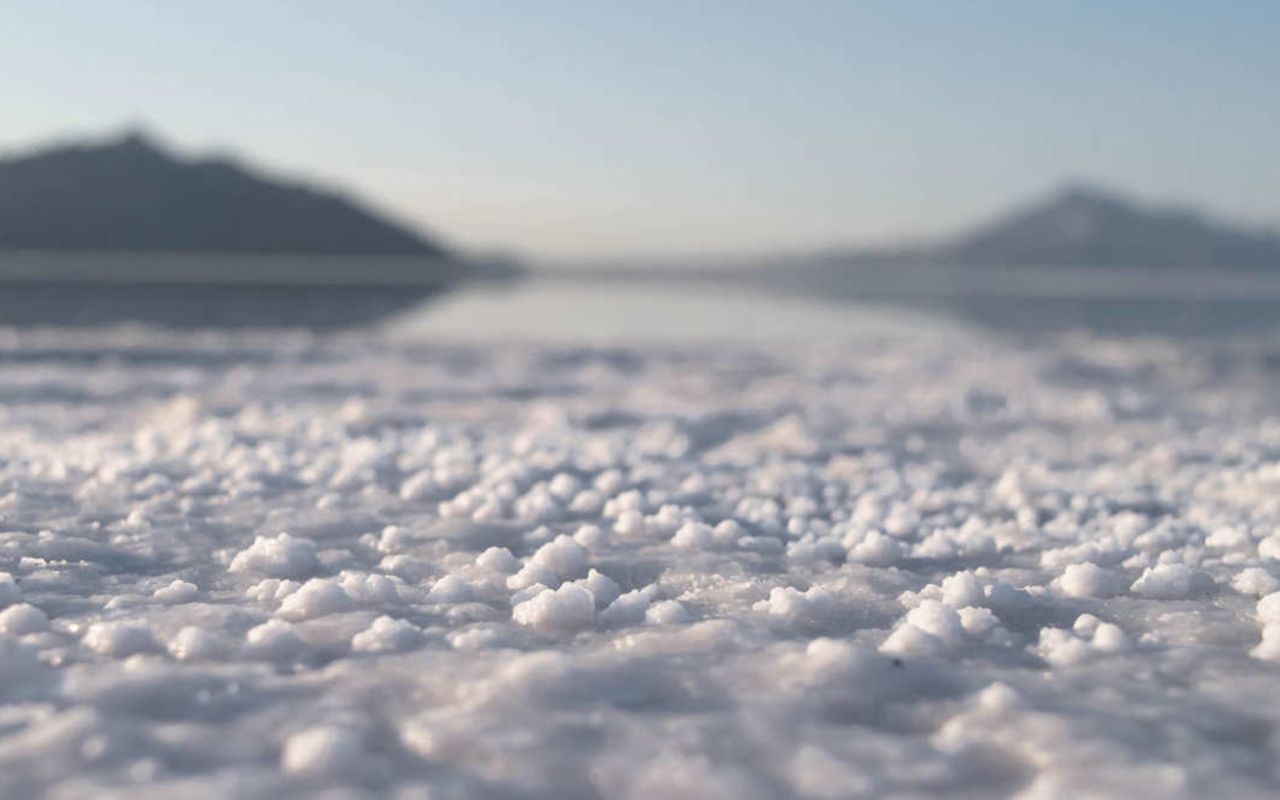Bonneville Salt Flats
Imagine a place so flat you seem to see the curvature of the planet, so barren not even the simplest life forms can exist.
Imagine the passing thunder of strange vehicles hurtling by on a vast dazzling white plain. This is not an alien world far from earth; it is Utah's famous Bonneville Salt Flats.
Click here to learn more about speed events at the Salt Flats.
Video by drone filmmaker @TappChannel | Follow on Instagram: tapp_channel
Read more…
Promotional Links
The Bonneville Salt Flats
The Bonneville Salt Flats is one of the most unique natural features in Utah, stretching over 30,000 acres. It is located along I-80 near the Utah-Nevada border.
Location
The Bonneville Salt Flats are found west of the Great Salt Lake, in western Utah. They cover a large area and have a very unique environment. The flats can easily be seen as you drive I-80 between Salt Lake City and Wendover, NV.
The famous Bonneville Speedway is located in the western portion of the flats, near Wendover. It is perfectly flat and has a thick crust of salty soil. It looks like a frozen lake bed covered with snow. No vegetation grows in that area.
In other places, low mountains and hills break up the flat landscape. Sparse vegetation grows on hillsides and is pushing into the flat areas. On hot days, heat waves rise from the salty soil and create mirages that look amazingly real. If you believe your eyes, the dry desert looks like it is covered by water.
Best Viewpoint
Perhaps the most impressive spot to view the Salt Flats is along along I-80, about 10 miles east of Wendover. A rest stop has been established there (offering restrooms and water). The rest area is surrounded by perfectly flat land that looks like it is covered by snow. To the north and west, low mountains break the view. To the east and south, it looks like flat land extends virtually forever.
At the rest stop you can walk out onto the salty soil. When you return, a water spray station has been set up so you can wash the salt from your shoes.
Geology & Environment
The Salt Flats were formed when ancient lake Lake Bonneville dried up. The lake was huge, filling much of the Great Basin. It eventually shrank below its outlet and so its water became salty. As water continued to evaporate, salt deposits were left in many areas. The Great Salt Lake is a remnant of Lake Bonneville.
Several roads probe the Salt Flats from many directions. They often extend into very remote locations where conditions are harsh and there are no services.
The flats include a variety of micro environments. In some spots the soil is so salty it prevents vegetation growth. These spots seem to be totally desolate. In other places you will find numerous kinds of plants and animals. Ponds and marshy areas can be found in spots near the edges of the flats and they provide critical habitat for plants and animals.
The environment is fragile and needs to be treated with respect. When you drive, stay on established roads. If you camp or hike, do so in ways that are environmentally friendly.
The federal government owns almost all of the land in this area and large portions are used by the military for storage depots, test areas and bombing ranges. These sections are fenced and marked, and public access is prohibited.
A Barrier Of Salt- History
Humans have lived in the Great Basin for thousands of years. Excavations at nearby Danger Cave have proven occupation of the area as early as 10,300 years ago. While Native Americans adapted to the desert environment, more recent arrivals found the area less hospitable.
By 1824, Jim Bridger and other mountain men explored the Great Salt Lake desert region. The first recorded crossing of the desert was made in 1845 by Captain John C. Fremont's survey party, with scouts Kit Carson and Joe Walker. Early the next year, 23 year old Lansford Hastings retraced Fremont's trail across the salt plain. Joe Walker's writings warned emigrants not to attempt the untried route; however, Hastings convinced several emigrant parties to follow him.
Despite Walker's warnings, the Donner-Reed party, seeking a shortcut to California in 1846, attempted the "Hastings Cutoff". They failed to take enough water and lost a critical number of oxen. Four of their wagons were abandoned just 10 miles northeast of the salt flats. Time was lost, and the delay resulted in their late arrival to the Sierra Nevada Mountains and their tragic winter.
Later, in 1910, the first permanent crossing of the Bonneville Salt Flats was completed when the Southern Pacific Railroad was built linking Salt Lake City and San Francisco.
Ancient Lake Bonneville
Although he never visited the salt flats, the area is named in honor of Captain B.L.E. Bonneville, whose expeditions in the 1830's proved the area was part of an ancient basin.
During the last Ice Age, about 15,000 years ago, Lake Bonneville was the size of Lake Michigan. It covered one-third of present day Utah and parts of neighboring states. You can see traces of the shorelines, representing different levels of the receding lake, etched into the mountains surrounding the salt flats.
The Bonneville Salt Flats and the Great Salt Lake are remnants of ancient Lake Bonneville. Wind and water combine to create the flat surface of salt. Each winter, a shallow layer of standing water floods the surface of the salt flats. During spring and summer, the water slowly evaporates while winds smooth the surface into a vast, nearly perfect flat plain.
The salt surface contains potassium, magnesium lithium and sodium chloride (common table salt).
About Your Visit
The Bonneville Salt Flats is administered by the Bureau of Land Management for public use and enjoyment. Due to its unique geology, history, and scenic beauty, the Bonneville Salt Flats was designated an Area of Critical Environmental Concern in 1985.
Help preserve the Bonneville Salt Flats!
Stay on existing roads or areas designated for vehicles. Despite the appearance of a hard surface, much of the area is a thin salt crust over soft mud. It easily breaks under the weight of a vehicle.
Stay off the salt surface when it is covered by water. When wet, the salt surface is soft and easily damaged by vehicles. Furthermore, the salt water is highly corrosive and can "short-out" the electrical system in your vehicle.
Be prepared for desert conditions. Temperatures can exceed 100 degrees Fahrenheit in the summer and drop well below 0 in the winter.
There are no facilities or services on the salt flats. Temporary facilities are available during racing events.
Overnight stays are prohibited on the salt flats. Camping is encouraged on surrounding public lands. Private campgrounds and hookups are available in nearby Wendover, ten miles west of the Bonneville Salt Flats. Other accommodations and services are also available in Wendover. Call 1-866-299-2489 for more information.
Bonneville Salt Flats Events
People come from all over the world to Bonneville Salt Flats for land speed racing events.
Read an overview of Speed Events at the Bonneville Salt Flats in this article : Think You Know Fast? Not Until You Experience Bonneville Salt Flats Speed Events
THINGS TO DO NEARBY
- Hiking in Salt Lake City
- Salt Lake City Skiing
- Salt Lake City Guides & Outfitters
- Fishing
- Salt Lake City Mountain Biking
- Camping
- ATV/Offroad/Jeep Tours
- Great Salt Lake Boating
- Spas
- Salt Lake City Golf Courses
Bonneville Salt Flats | Photo Gallery


Bonneville Salt Flats
Other-worldy views can be seen on the Bonneville Salt Flats.
Location
Get DirectionsWendover Weather
Average Temperature
Average Precipitation
Average Snowfall
Articles
View AllThink You Know Fast? Not Until You Experience Bonneville Salt Flats Speed Events
A flat bed of pristine, crunchy salt is the perfect surface to set land speed records. Just ask the ...
Happy Trails in Piute County
What do Delano Peak, the Paiute ATV trail and Butch Cassidy all have in common? Utah’s Piute County,...
8 Secrets to Sustainable Travel in Park City
Want a big adventure to Park City without a big environmental footprint? Utah.com can help you explo...
Utah County Is Festive As Heck
Fireworks, parades and corn on the cob — oh my! Utah.com has the scoop on the best festivals and fai...
Natural Bridges National Monument: A Hidden Gem, Not a Second Fiddle
An under the radar destination that should be on your radar. Learn all about Natural Bridges, Utah a...
Plan a Guys Getaway in Vernal
Planning a guys trip? Why not hit the ATV trails in Vernal, Utah with your crew? With all kinds of w...
Treat Yourself to a (San Rafael) Swell Winter
The San Rafael Swell is one of Utah’s hidden gems, and it gets even more hidden in the winter. Utah....
Plan a Triathlon of Fun in Greater Zion
Looking for things to do in St. George this fall? In addition to the IRONMAN 70.3 World Championship...
Color Me (Insert Emotion Here): Where to See Cedar City’s Feel-Good Fall Foliage
Richly hued views await you in southern Utah this autumn. Peep the changing leaves on a scenic drive...
Play Outside and See a Play Outside in Cedar City
Take a visit to Cedar City, Utah, and see why its access to both world class theater and stunning ou...
Mapping Out Utah’s Tastiest Cuisine
Getting to know the Beehive State means experiencing its sites and unique flavors. Discover both whe...
Get Your Peach Thrills in Box Elder County
Utah’s Box Elder county is a peachy paradise — part mountain range, part desert, part orchard and al...
9 Highest Peaks Across Utah
Take a peek at the tallest peaks in Utah. From Kings Peak to the Deep Creeks, Utah.com gets to the t...
Paving the Way for Everyone: All-Access Trails in Utah
From a wheelchair accessible waterfall trail to a lakeside boardwalk laden with wildflowers, these U...
Local Legends in Utah
Ever been curious about urban legends in Utah? Utah.com fills you in all things folklore with our gu...